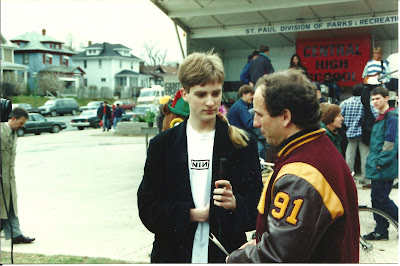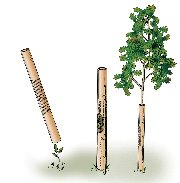 "Perhaps one in a billion seeds becomes a mature tree." Dr. Edward F. Gilman
"Perhaps one in a billion seeds becomes a mature tree." Dr. Edward F. GilmanSo what does that have to do with an ugly boxelder tree growing through the rotted out floor of a Dodge pickup truck? Glad you asked.
Where can a poor defenseless seed find a place in nature to germinate that provides all that protection to overcome the billion to one odds? This magical or miracle location must be free of seed eating animals, protected from rabbits and deer, partially shaded against the drying sun, and not have competing weeds.The first sentence in Dr. Edward Gilman's brilliant article Roots of change for the better has the "billion to one-shot" claim for a seed. He goes on to list many of the hurdles a tree seed faces trying to get established. We seel product to overcome those problems at www.plantra.com. With this post I want to talk about where that billionth seed must grow to become a tree.
Seeds are tasty and need protection from herbivores. Seedlings are delicate and also need shelter from drying winds and intense sunlight. Some of the problems a seedling faces include rodents, rabbits, deer, wind, and drought. A tree seedling needs enough sunlight for photosynthesis but it cannot compete out in the open for water and sun with grasses and weeds.
 Now we know why trees play the odds and produce so many seeds.
Now we know why trees play the odds and produce so many seeds.My two favorite examples are rock crevices and the brushy tops of fallen trees. Hard to imagine those two environments have anything in common, but both have the potential under ideal weather conditions to protect and nurture a seed.
A seed in a rock crevice is partially shaded and has all the moisture in the crevice for itself. What about rodents? Well, voles and mice will not leave the cover of weeds. Why? Because rodents fear death from above brought by raptors. While there might be some weeds in the rock crevice, a thin line of grass does not provide attractive cover for rodents. So hard as it is to believe, a crack in a rock can be a great place for a tree to start life. Took the picture below last spring in Colorado outside of Estes Park. And yes that tree is growing straight out of a rock - as were many others in the area.

Why is a fallen tree top a great place for a seedling? Remember we are talking billion to one shot odds, so it
 is OK to line up the coincidences.
is OK to line up the coincidences.Many seeds need contact with mineral soil or bare dirt to germinate. What better way to scrape away some leaf duff on the forest floor than branches crashing to the ground? Big animals such as deer cannot penetrate the dense mass of compressed branches protecting our new seedling.
Voles are likely to seek the raptor free shelter of a fallen tree, so how do our fortunate seed and seedling survive? Good shelter is hard to find and our lucky brush pile is also home to a family of snakes, or skunks if you prefer. We don't have to kill all the rodents to grow a tree. We just have to give them a good reason to go elsewhere. Snakes are a great reason for mice to go elsewhere and snakes don't eat trees.
What about weeds? A forest floor has inches of natural mulch to block weeds. Our tree seed is in a small spot where the mulch was scraped away. It will take a while for the small forbs to get through the duff (mulch) and catch up to the larger tree seedling.
Underneath the truck bed it is weed free, protected from drying sun and wind. The seed germinates and the radicle grows directly into mineral soil. The truck bed provides cover for a carnivore that keeps the rodents away. There is a small gap in the rotting floor boards. The light seeking apical meristem pours all the available energy into growing through that gap and into the sunlight. It still has to get past the deer. Our fortunate seedling is protected by the structure of the pickup bed.

While keeping four hooves on the ground the deer mouth can only reach so far in and our box elder is just out of reach. Now if box elder was something the deer really wanted or the deer was starving the it could jump right up in the pickup bed. Fortunately box elder is mostly unwanted by man and deer - so it thrives.

Below is a copy of our Stages Of Seedling Establishment available on our website at the link. It is amazing to me how a crack in a rock, an abandoned Dodge pickup truck, a brush pile and a tree tube all provide the nurturing micro-environment a seed needs to overcome the nearly insurmountable odds to become an established tree.

















































